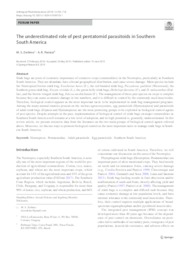The underestimated role of pest pentatomid parasitoids in Southern South America.
The underestimated role of pest pentatomid parasitoids in Southern South America.
Author(s): ZERBINO, M. S.; PANIZZI, A. R.
Summary: Stink bugs are pests of economic importance of extensive crops (commodities) in the Neotropics, particularly in Southern South America. They are abundant, have a broad geographical distribution, and cause severe damage. Main species include the Neotropical brown-stink bug, Euschistus heros (F.), the red-banded stink bug, Piezodorus guildinii (Westwood), the Southern green stink bug, Nezara viridula (L.), the green-belly stink bugs, Dichelops furcatus (F.), and D. melacanthus (Dallas), and the brown-winged stink bug, Edessa meditabunda (F.). The management of these pest species on crops is complex because they can cause economic damage in low numbers, and it is difficult to control by the commonly used insecticides. Therefore, biological control appears as the most important tactic to be implemented in stink bug management programs. Among the many natural enemies present on the various agroecosystems, egg parasitoids (Hymenoptera) and parasitoids of adult stink bugs (Diptera and Hymenoptera) are the most promising groups to be exploited as biological control agents of pest species. Despite attempts in the past, implementation of biological control of stink bugs on major commodities in Southern South America still remains at a low level of adoption, and its high potential is, generally, underestimated. In this review article, we present extensive data from the literature on the two main groups of biological control agents referred above. Moreover, we discuss ways to promote biological control as the most important tactic to manage stink bugs in Southern South America. Keywords Heteroptera · Pentatomidae · Adult parasitoids · Egg parasitoids · Southern South America
Publication year: 2019
Types of publication: Journal article
Unit: Embrapa Wheat
Observation
Some of Embrapa's publications are published as ePub files. To read them, use or download one of the following free software options to your computer or mobile device. Android: Google Play Books; IOS: iBooks; Windows and Linux: Calibre.
Access other publications
Access the Agricultural Research Database (BDPA) to consult Embrapa's full library collection and records.
Visit Embrapa Bookstore to purchase books and other publications sold by Embrapa.

